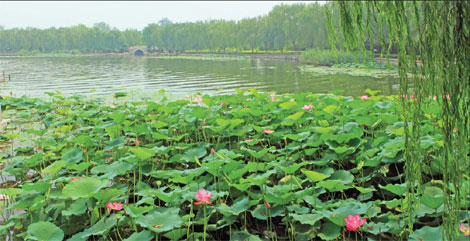Wellspring of beauty
Updated: 2012-02-10 09:37
(China Daily)
|
||||||||
|
Located to the north of the center of Jinan, Daming Lake is the largest of its kind in the historic city. [Yan Xiangqun / For China Daily] |
City on Shandong peninsula draws on its natural and cultural heritage
Straddling the Yellow River and the Taishan Mountain Range, Jinan taps into what many Chinese believe to be a perfect geomantic combination of "holy water and sacred highland". Throughout the ages, the Yellow River has nurtured the capital of Shandong province to help it become the site of an impressive number of cultural attractions.
Jinan has been an administrative center of the Shandong peninsula since the Ming Dynasty (1368-1644) and it is considered a major provincial capital in both the economic and cultural spheres.
The city offers views of mountain ranges from its suburbs and hiking is popular among residents.
Jinan is located in a semi-basin area and mountains on its southern side help keep it warm during the winter months.
Confucianism has played a pivotal role in the region since the Qi and Lu kingdoms in the Spring and Autumn Period (770-476 BC). Even now, locals address visitors as "teacher" as a form of respect. Buddhism is another major aspect of the city, with numerous historic Buddhist sites located in the surrounding areas.
Three attractions in Jinan that visitors should not miss are:
1. Baotu Spring
Jinan is famous in China as the "City of Springs", with its large number of natural artesian springs. The most famous ones have been described as the "72 Famous Springs". Some are concentrated in the downtown area and flow north to converge in Daming Lake.
Black Tiger Spring in the south and Baimai Springs in the east are big drawcards, but there is one spring that stands out - Baotu Spring, drawing rulers since ancient times. Emperor Qianlong of the Qing Dynasty (1644-1911) hailed it as the First Spring under Heaven. The emperor's inscription "Baotu Spring" is carved on a tablet that was placed beside the pool after he went there. Baotu means "jumping and leaping", and the pool is the result of three readily discernible springs that give the overall impression of a pot of boiling water.
The pool is surrounded by historic structures such as Leyuan Hall, Guanlan Pavilion and Laihe Bridge. Wangheting Teahouse is nearby. Other noteworthy structures include the Banbi Corridor and the Waterside Chamber. The largest architectural ensemble is the 10,000 Bamboo Garden. Other gardens and architectural attractions in the park include the Cang, Luoyuan and Hundred Flowers gardens. Baotu Spring public park also includes memorials to local painters such as Li Kuchan and Wang Xuetao, as well as the poet Li Qingzhao.
2. Daming Lake
Located to the north of the center of Jinan, the lake is the largest of its kind in the historic city. Fed by the springs, Daming maintains a healthy water level. Its name means "the lake of the great splendor".
Nine small islands form an integral part of the lake - Cuiliuping, Niaoqingqiqi, Guting, Mingshi, Huiquan, Huxin, Jiaxuan, Qiuliu and Huju islands. The names are derived from various historical and cultural backgrounds. These islands together with the lake provide a wonderful natural stage for architectural attractions like pavilions that reflect the beauty of the landscape.
Lake Center Pavilion got its name from the Huxin (meaning center of the lake) Island it is built on. Jiuqu Pavilion literally means nine bends. Haoran Pavilion refers to broad mind. Xiaocanglang Pavilion is interpreted as Little Rippling Wave Pavilion. Lixia Pavilion is said to mark the spot of a meeting between the Tang Dynasty poet Du Fu and the calligrapher Li Yong.
There are also halls that reflect the cultural depth of the area. In memory of the Ming Dynasty official Tie Xuan, a memorial hall named Ancestral Hall of Lord Tie was set up in the Qing Dynasty. Nanfeng Ancestral Hall was built to remember Song Dynasty scholar Zeng Gong. And Jiaxuan Ancestral Hall was built to commemorate Xin Qiji, a military leader and statesman of the Southern Song Dynasty who was born in Jinan.
The lake park also includes buildings like theaters and temples, and some of them still serve as places for public activities. The view of the lake is embellished by the many gardens embodying traditional Chinese features that surround it. In summer, people head to the area just to view the beautiful lotuses.
3. Thousand Buddha Mountain
The mountain was originally called Li Mountain, where crops planted by ancient emperors are supposed to have grown. Its name changed during different dynasties, and during the Sui Dynasty (AD 581-618), with the rise of Buddhism, Emperor Wen began to dig caves and build Buddhist structures.
A temple called Thousand Buddha Temple was built and the mountain was renamed after the temple, which is still there. Emperor Taizong of the Tang Dynasty later enlarged the temple and named it Xingguochan Temple. The temple then became a popular location for offering incense. Temple events have been held on special Chinese festivals since the Yuan Dynasty (1271-1368).
China Daily


 Relief reaches isolated village
Relief reaches isolated village
 Rainfall poses new threats to quake-hit region
Rainfall poses new threats to quake-hit region
 Funerals begin for Boston bombing victims
Funerals begin for Boston bombing victims
 Quake takeaway from China's Air Force
Quake takeaway from China's Air Force
 Obama celebrates young inventors at science fair
Obama celebrates young inventors at science fair
 Earth Day marked around the world
Earth Day marked around the world
 Volunteer team helping students find sense of normalcy
Volunteer team helping students find sense of normalcy
 Ethnic groups quick to join rescue efforts
Ethnic groups quick to join rescue efforts
Most Viewed
Editor's Picks

|

|

|

|

|

|
Today's Top News
Chinese fleet drives out Japan's boats from Diaoyu
Health new priority for quake zone
Inspired by Guan, more Chinese pick up golf
Russia criticizes US reports on human rights
China, ROK criticize visits to shrine
Sino-US shared interests emphasized
China 'aims to share its dream with world'
Chinese president appoints 5 new ambassadors
US Weekly

|

|







